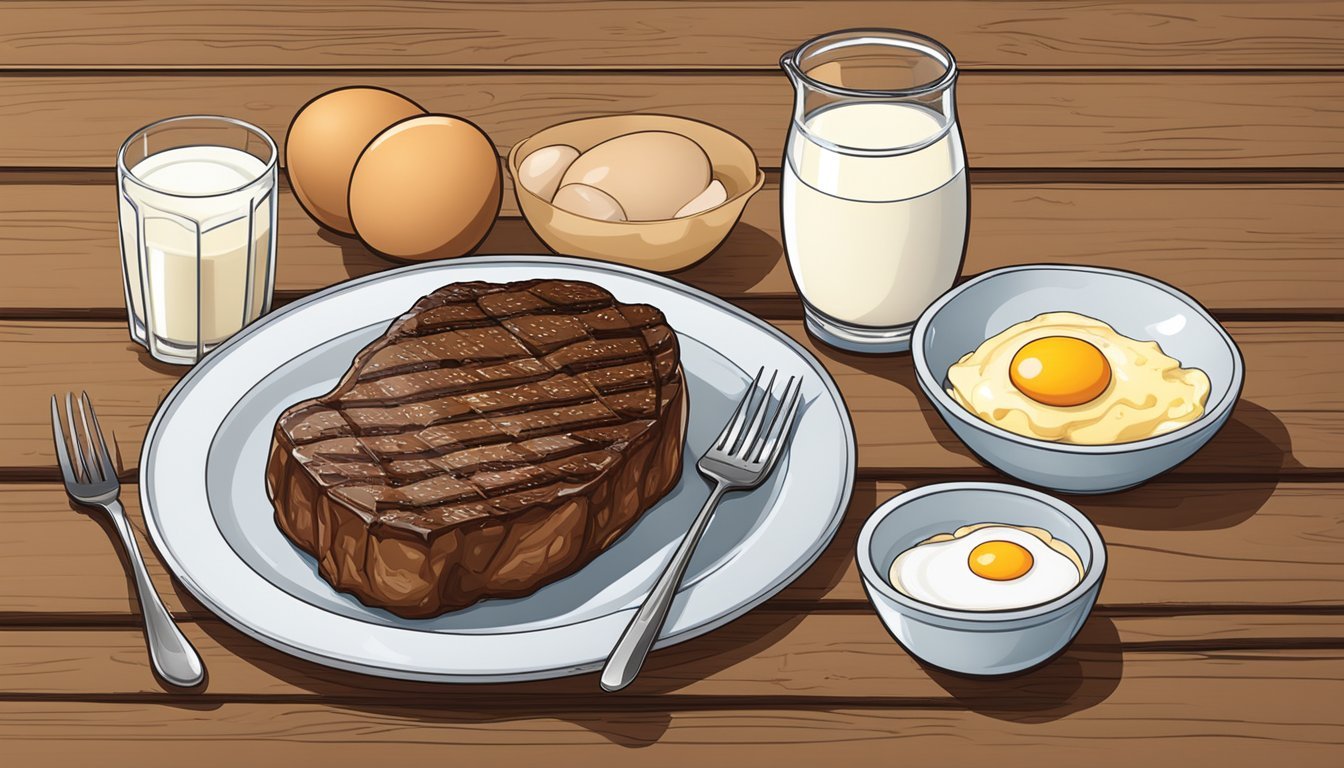The Carnivore Diet for Ballet Dancers
Optimizing Performance through Targeted Nutrition
Ballet dancers demand exceptional levels of strength and flexibility, performance attributes that are heavily influenced by their nutrition. While traditionally, a dancer's diet might prioritize a balance of carbohydrates, proteins, and fats, some are turning their attention to less conventional eating patterns, such as the carnivore diet. This regimen, focused on the consumption of primarily animal products like meat, organs, and eggs, claims to provide the necessary nutrients for high-intensity physical performance and recovery.
The carnivore diet is a topic of interest for its potential to support muscle maintenance and growth, aspects critical to a ballet dancer's strength. It operates on principles distinct from the typical dietary recommendations for dancers, which suggest a substantial carbohydrate intake to fuel prolonged rehearsals and performances. Advocates of the carnivore diet suggest that a meat-centric approach may have particular benefits for strength, though the implications on flexibility and overall nutritional balance are areas worth investigating.
Nutrition is a cornerstone for a ballet dancer's career longevity and day-to-day energy levels. The shift towards a carnivore diet must, therefore, be examined with caution, considering the dancer's rigorous training schedule and the need for a diet that supports not just strength and flexibility, but also general health. While the carnivore diet offers a high intake of certain nutrients like protein and iron, the exclusion of plant-based foods raises questions about the diversity and adequacy of a dancer's nutrient intake, suggesting that more research and professional guidance is necessary to ensure dietary decisions align with optimal performance and well-being.
The Carnivore Diet Explained
The Carnivore Diet focuses on consuming animal-based foods high in protein and fat, while eliminating plant-based foods. This section unpacks the diet's foundational concepts, its dietary makeup, and how it stands apart from other nutritional approaches.
Origins and Principles
The Carnivore Diet has its roots in the belief that early humans thrived on a meat-dominant diet. It operates on the principle that one can achieve better health by exclusively consuming animal products that are dense in nutrients, such as vitamins and minerals. By relying solely on animal sources, the diet is intrinsically low in carbohydrates and void of plant-based foods.
Major Components of the Diet
Meat: Beef, pork, chicken, fish, and turkey form the core of the diet.
Eggs and Dairy: Eggs are a staple, with some variations of the diet allowing for low-lactose dairy.
Fat: High intake of saturated fat from animal sources.
Organs: Consuming organ meats like liver for their nutrient density.
A typical food intake emphasizes high protein and high fat, aiming to cover the recommended daily intakes of essential macronutrients. On the Carnivore Diet, foods rich in vitamins, like B12, and minerals, such as iron and zinc, are prioritized through the consumption of animal flesh and organs.
Contrast with Other Diets
Unlike plant-centric diets, the Carnivore Diet requires one to eliminate fruits, vegetables, grains, and nuts. This exclusion can lead to a different micronutrient profile compared to diets that include a wider variety of foods.
Carbohydrates
Carnivore Diet: Minimal
Other Diets: Moderate-High
Protein
Carnivore Diet: High
Other Diets: Varies
Fats
Carnivore Diet: High
Other Diets: Varies
Vitamins/Minerals
Carnivore Diet: Animal-Sourced
Other Diets: Broad-Sourced
Those adhering to the Carnivore Diet may report improved mental health and energy availability due to the satiating nature of the diet. However, the absence of certain plant-based nutrients might contribute to potential health issues over the long term. Critics of the diet caution about the risks of excessive saturated fat intake and the lack of dietary fiber.
Advantages of Carnivore Diet for Ballet Dancers
The carnivore diet may offer specific benefits tailored to the needs of ballet dancers, focusing on improved performance and enhanced muscle recovery. This meat-centric diet aligns with the energy demands of dancers.
Improving Performance and Power
Energy & Strength: A diet high in protein delivers a consistent source of energy essential for ballet dancers, who engage in rigorous training routines. The body can utilize the amino acids from protein to maintain muscle strength and power, which are critical for executing challenging choreographic movements.
Sustained Power: With the emphasis on protein and fat, the carnivore diet might help maintain dancers' power throughout long rehearsals and performances. Fats, as a concentrated energy source, may provide the necessary fuel to perform intense dances without the quick spikes and drops in energy associated with high-carb diets.
Aiding Muscle Growth and Recovery
Growth: Proteins provide the building blocks for muscle growth. A ballet dancer's body can use the increased protein intake from a carnivore diet to develop and maintain the muscular physique required for ballet's demands.
Recovery: After intensive training and performances, muscle recovery is paramount for ballet dancers. The amino acids found in animal proteins support the repair of muscle tissues, helping to reduce recovery times and prepare dancers for their next session in the studio.
Nutritional Balance and Considerations
When discussing the carnivore diet for ballet dancers, one must ensure that the focus is on achieving nutritional balance while addressing the challenges inherent in consuming an exclusively animal-based menu. Ballet dancers require a diet tailored to provide the necessary energy for demanding training sessions while supporting muscle, bone, and overall body health.
Addressing Potential Nutrient Deficiencies
While the carnivore diet is rich in protein, it can lack certain micronutrients critical for a ballet dancer's health and performance. Ballet dancers must be vigilant about potential deficiencies, particularly in:
Vitamin C: typically found in fruits and vegetables, crucial for immune function and tissue repair.
Fiber: essential for digestive health, but absent in an animal-only diet.
Periodic nutritional assessments are prudent to ensure no critical elements are missing from a dancer's dietary intake.
Incorporating Necessary Vitamins and Minerals
Ballet dancers must maintain strong bones and supple muscles. Two key nutrients in this process are calcium and vitamin D. Calcium is vital for bone density and muscle function, while vitamin D is essential for calcium absorption and bone health. Here is how ballet dancers can include these nutrients:
Dairy products: High in calcium and often fortified with vitamin D; cheese and yogurt are suitable options.
Fatty fish: Salmon and mackerel, for instance, offer both vitamin D and Omega-3 fatty acids.
Iron is another critical mineral for dancers, aiding in oxygen transport and energy levels. Red meat, an element of the carnivore diet, is an excellent source of heme iron, which is readily absorbed by the body.
The Role of Supplements
Supplements may be necessary to balance a ballet dancer's nutrient intake on the carnivore diet. Here are areas where supplementation might be considered:
Vitamin C supplements: to help counteract the lack of fresh fruits and vegetables.
Iron supplements: for individuals who might still experience deficiencies despite dietary intake.
Fiber supplements: to assist with digestive health and regularity.
However, ballet dancers should consult with a healthcare provider before starting any supplement regimen to tailor their needs accurately.
I always prefer buying vitamin C, iron, and fiber supplement online because of the added convenience!
Carnivore Diet Meal Planning
Crafting a meal plan for a ballet dancer on a carnivore diet involves careful consideration of nutrient-dense proteins and healthy fats to sustain energy levels while supporting muscle strength and recovery. Ballet demands physical endurance and flexibility, making it crucial to optimize pre- and post-rehearsal nutrition.
Daily Meal Suggestions for Dancers
Breakfast:
A dancer might start the day with scrambled eggs topped with cheddar cheese for a protein-rich meal that provides sustained energy.
Lunch:
Lunch could consist of a turkey burger (no bun) topped with a fried egg, ensuring a midday boost of protein.
Dinner:
Dinner could be as hearty as a pork chop cooked in butter, providing both protein and healthy fats for overnight muscle recovery.
Snacks:
Snacks are important for maintaining energy levels and might include a selection of low-lactose cheeses or a handful of smoked salmon slices.
Pre- and Post-Rehearsal Nutrition
Pre-Rehearsal:
Prior to rehearsals, dancers might focus on lighter protein sources like chicken breasts or smoked salmon to fuel their session without feeling heavy.
Post-Rehearsal:
After rehearsal, incorporating a more substantial meal with protein, such as an organ meat pie, can aid in muscle recovery and replenishment of energy reserves.
Hydration:
Adequate hydration is crucial; bone broth can provide both hydration and nutrients essential for a dancer's physical demands.
Incorporating these meal suggestions helps ballet dancers following a carnivore diet to maintain their physical prowess and optimize performance during rigorous rehearsals.
Physical Benefits for Dance Performance
The Carnivore Diet, focused on consumption of animal products, can impact a ballet dancer's ability to perform by potentially enhancing muscle strength and altering body composition.
Enhanced Strength and Flexibility
A ballet dancer's repertoire demands a symbiotic relationship between strength and flexibility. The consumption of high-quality protein typical of a Carnivore Diet provides the essential amino acids necessary for muscle repair and growth. Protein-rich diets support the strenuous training ballet dancers undergo, which is pivotal for both power in jumps and endurance in lengthy performances. For instance, the requisite strength to perform difficult lifts and maintain demanding postures comes from robust muscle development supported by adequate protein intake.
Ballet dancers also require supreme flexibility to execute a full range of movements. While a diet alone cannot improve flexibility, the nutrients from a Carnivore Diet may support the muscle recovery process. This, combined with consistent stretching and resistance training, such as using resistance bands or engaging in Pilates, can help dancers maintain and improve their flexibility.
Optimized Body Composition and Endurance
The Carnivore Diet may influence a dancer's body composition by increasing muscle mass and potentially reducing excess body fat, given its high protein and low carbohydrate profile. A lean but muscular physique is beneficial for dancers, as it enhances aesthetics and performance while also minimizing the risk of injury.
Endurance is another critical aspect of a ballet dancer's performance. Energy requirements for extended rehearsals and performances can be substantial. Although a typical Carnivore Diet is low in carbohydrates, the body can adapt to use fats and proteins as an energy source. This metabolic adaptation could sustain a dancer's energy levels throughout long sessions but should be closely monitored to ensure it meets the individual energy demands for peak performance.
Psychological Aspects of Diet in Ballet
The psychological consequences of a dancer’s diet can profoundly affect both performance and wellbeing. Dancers often encounter unique pressures surrounding food that contribute to their mental health and their relationship with food.
Impact on Mental Health and Focus
Mental health is closely intertwined with a dancer's dietary habits. A demanding schedule requires impeccable focus, and a balanced diet plays a pivotal role in maintaining cognitive clarity. Yet, the stringent dietary practices often adopted in ballet can lead to disordered eating, impacting a dancer's psychological state. A deficiency in essential nutrients may cause fatigue and diminished concentration, hindering performance.
Conversely, a diet that includes a variety of nutrients can support neural function and emotional stability. The key for dancers is to find that delicate balance where their diet supports both their strenuous physical activity and their mental health needs.
Managing Relationship with Food
Dancers often adhere to strict food rules to maintain the body aesthetics deemed ideal for ballet. These rules, while sometimes effective for short-term goals, can strain their relationship with food over the long term. This tension can prompt cravings or feelings of guilt associated with eating, potentially leading to disordered eating patterns.
Developing a healthy relationship with food involves recognizing it as a source of nourishment rather than a set of restrictions. It’s about including a variety of food choices, fostering a balanced diet, and listening to the body's hunger and fullness cues. By doing so, dancers can build a sustainable approach to eating that favors their well-being and artistic performance.
Challenges and Considerations
The Carnivore Diet emphasizes a high intake of animal-based foods that ballet dancers may adopt for potential strength gains. Yet, this choice introduces distinct nutritional challenges and considerations in pursuit of peak performance and health.
Common Misconceptions Debunked
Myth: The Carnivore Diet provides all the necessary nutrients for ballet dancers. Reality: Ballet dancers typically require a balanced diet, rich in carbohydrates, for energy. The Carnivore Diet, which is predominantly protein and fat, can lead to an energy deficiency affecting performance.
Myth: A meat-only diet ensures optimal strength and body composition for dancers. Reality: Balanced diets that include a range of nutrients contribute to dancers’ muscle development and recovery. A meat-centric approach may overlook essential nutrients found in other food groups, such as vitamins and minerals vital for flexibility and muscle function.
Potential Risks and How to Mitigate Them
Injury: The lack of certain nutrients may lead to an increased risk of bone injuries. Ballet dancers are advised to work with a nutritionist to incorporate a variety of nutrients that support bone health.
Deficiency: Nutrient deficiencies, particularly in iron, calcium, and B vitamins, can occur without proper planning. Nutritionist guidance is crucial to identify and supplement any nutritional gaps.
Health Issues: A diet lacking fiber and certain micronutrients can lead to digestive and other long-term health issues. Diversifying food sources may prevent such conditions.
Consultation: Dancers should consult with a certified counselor of intuitive eating to develop a dietary plan that acknowledges their body’s signals and promotes sustainable eating behaviors while mitigating risks associated with restrictive diets.
A holistic approach to nutrition is paramount for dancers considering the Carnivore Diet, addressing these considerations with informed and professional support to maintain their health and performance.
The Role of Healthcare Professionals
Healthcare professionals play a pivotal role in ensuring that ballet dancers following a carnivore diet maintain optimal health and performance. They provide specialized dietary advice and monitor the dancers' unique nutritional requirements.
Consulting with a Registered Dietitian Nutritionist
Consultation with a Registered Dietitian Nutritionist (RDN) is essential for ballet dancers. An RDN assesses individual dietary needs and helps dancers navigate the challenges of a carnivore diet while ensuring they get the necessary nutrients to support strength and flexibility. They also:
Develop meal plans tailored to energy demands
Monitor overall health and identify potential nutrient deficiencies
Collaborating with Sports Nutrition Specialists
Certified Specialists in Sports Nutrition provide crucial support to dancers on a carnivore diet. They work closely with ballet dancers to:
Offer guidance on optimal protein intakes and recovery nutrition
Strategize hydration and fueling for intense training and performances
These healthcare professionals ensure that the diet choices of ballet dancers support the rigorous demands of their discipline while maintaining their overall health.
Final Thoughts
The section ahead encapsulates the essence of the balanced intersection between a strict carnivore diet and its implications for ballet dancers striving for peak performance.
Summary of Key Takeaways
The carnivore diet, typically rich in animal products, may offer protein for muscle repair but is less aligned with the balanced energy needs of a ballet dancer. Ballet dancers require not only strength but also finesse and endurance, which is fostered by a comprehensive nutritional strategy that includes a variety of food groups, such as carbohydrates for energy.
High-protein intake from meats aids in muscle repair and recovery which is significant for any athlete's health.
The absence of nutrient-rich plant foods may lead to deficiencies, impacting overall health and performance.
Athlete health thrives on a diet that supports the rigorous physical demands of ballet, including a healthy balance of macronutrients.
A strict carnivore diet could pose challenges in long-term adherence and nutritional balance, which could affect a dancer’s overall well-being and career longevity.
It’s evident that while the carnivore diet aligns with certain strength-building aspects, a more inclusive approach may serve the multifaceted nutritional requirements of ballet dancers.













